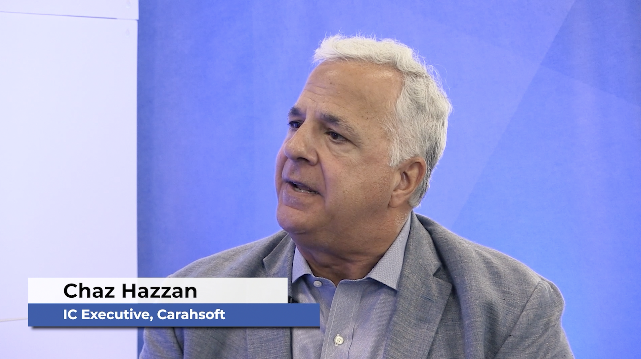Original broadcast 11/19/25
Presented by Carahsoft
The Indo-Pacific region is the most strategically contested, economically essential, and geographically expansive theater on Earth. It spans more than half the planet’s surface, contains 60 percent of the world’s population, and is home to seven of the world’s eight largest standing armies. For COL Sean Berg, USA (Ret.), former Deputy Commander of Special Operations Command Pacific (SOCPAC), these realities form the cornerstone of a concept he calls persistent global sensing—a foundational requirement for maintaining stability, deterrence, and competitive advantage in this increasingly dynamic region.
During his years at SOCPAC and across a career defined by special operations leadership, Berg witnessed firsthand the evolution of strategic competition in the Indo-Pacific. He argues that understanding the environment—people, places, technology, infrastructure, and the intent behind actions—is not simply a matter of intelligence gathering. It is a matter of survival in an era when adversaries are shaping the battlespace long before conflict becomes conventional.
Persistent global sensing, as Berg describes it, is not limited to traditional surveillance or reconnaissance. It is a holistic approach to awareness—one that requires the integration of sensors, human networks, commercial data, cyber insights, economic indicators, and geopolitical context into a single, coherent picture. In a region as large as the Indo-Pacific, that picture must be continuously updated and shared across services, commands, and allied nations.
 Berg warns that the United States and its partners are already behind in certain areas. While the U.S. focused for two decades on counterterrorism campaigns in the Middle East and Southwest Asia, adversaries—most notably the People’s Republic of China (PRC)—advanced rapidly through the phases of irregular warfare, shaping the environment below the threshold of open conflict. They used economic influence, information manipulation, infrastructure investment, and technological penetration to alter regional balances of power.
Berg warns that the United States and its partners are already behind in certain areas. While the U.S. focused for two decades on counterterrorism campaigns in the Middle East and Southwest Asia, adversaries—most notably the People’s Republic of China (PRC)—advanced rapidly through the phases of irregular warfare, shaping the environment below the threshold of open conflict. They used economic influence, information manipulation, infrastructure investment, and technological penetration to alter regional balances of power.
This competition is not theoretical. It is active, ongoing, and increasingly sophisticated. The PRC has leveraged commercial technologies, metadata, and vast digital footprints to create its own version of persistent sensing—often through means that would be prohibited in democratic systems. Berg notes that almost all data created since 2013 still exists somewhere, due to the low cost of digital storage. Commercial ad-tech platforms harvest information not just for marketing, but for detailed pattern-of-life analysis: gait recognition, location history, behavioral modeling, and more.
That data, which consumers often provide unwittingly, is now a strategic commodity. Nation-states no longer need intelligence operatives to build individual profiles; they can buy them.
In this environment, Berg argues, the race for quantum computing becomes existential. Whichever nation achieves quantum advantage first will unlock decades of encrypted data, analyze massive datasets instantaneously, and achieve predictive insights well beyond today’s capabilities. Persistent global sensing will shift from reactive monitoring to anticipatory awareness.
Yet Berg is equally clear about the non-technical side of the equation: presence matters. No sensing system—no matter how advanced—can substitute for forward posture. Whether through special operations forces, diplomatic teams, logistics hubs, or joint exercises, the United States must invest in human and physical infrastructure across the first, second, and third island chains. Being present is a vote of confidence to allies and a deterrent to adversaries.
As Berg recounts from years of engagement with regional political leaders, many Indo-Pacific nations stand at the intersection of geography, economics, and national survival. They rely heavily on Chinese trade and investment but prefer a free and open regional order. Their challenge is navigating the political cost of choosing sides. Their digital backbones, port infrastructure, telecom systems, and supply chains are often already intertwined with PRC influence.
For this reason, Berg argues, the U.S. must provide viable alternatives—technologically, economically, and diplomatically. Corporate partners have a critical role to play, but must avoid proprietary or closed systems that hinder coalition interoperability. Instead, they must invest in open, modular, adaptable platforms that can integrate with allied systems and evolve quickly. The pace of modern technology means that any rigid solution delivered today may be obsolete within a year.
This adaptability is equally important in the information domain. Data-sharing across allies and partners is both a necessity and a risk. Metadata can inadvertently reveal intent or expose operations, making cybersecurity and access control critical elements of partnership. As Berg emphasizes, the Indo-Pacific requires a careful tightrope walk: sharing enough to build trust and prevent escalation, but not so much that adversaries can infer sensitive patterns.
Above all, Berg stresses that irregular warfare—not conventional conflict—will define the coming decades in the region. The U.S. cannot wait for crisis to deploy resources. It cannot assume that presence can be surged overnight. Instead, it must continuously invest in regional relationships, capabilities, and sensing architectures that illuminate the environment long before adversaries take decisive action.
If the United States can combine persistent sensing, forward presence, quantum-ready technology, and deep partnership with allies, it can maintain a free and open Indo-Pacific. But without these investments, Berg warns, the strategic balance could shift rapidly—and irreversibly.
Key Takeaways
-
Persistent global sensing is essential to awareness, deterrence, and stability across the Indo-Pacific.
-
Adversaries have advanced deep into irregular warfare, shaping the environment below the threshold of conflict.
-
The U.S. must pair forward presence with open, adaptive, and quantum-ready technologies to maintain advantage.



